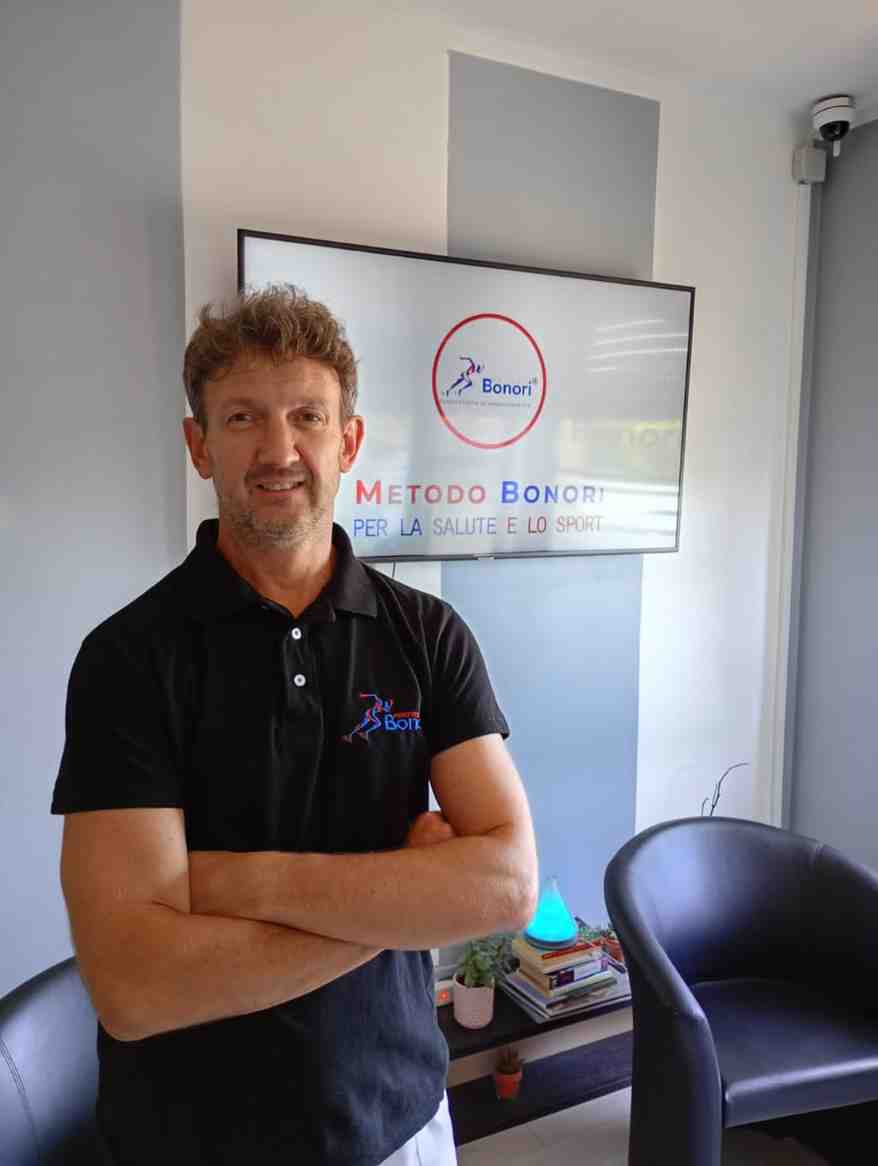AUCTORES
Globalize your Research
Review Article | DOI: https://doi.org/10.31579/2692-9562/132
Department of Pharmacy, University of Karachi, Pakistan.
*Corresponding Author: Rehan Haider, Department of Pharmacy, University of Karachi, Pakistan.
Citation: : Rehan Haider, Asghar Mehdi, Geetha Kumari Das, Zameer Ahmed, Sambreen Zameer, (2024), Quinolones: Development, Mechanism of Action, and Clinical Applications of Synthetic Antibiotics, Journal of Clinical Otorhinolaryngology, 6(5); DOI:10.31579/2692-9562/132
Copyright: © 2024, Rehan Haider. This is an open access article distributed under the Creative Commons Attribution License, which permits unrestricted use, distribution, and reproduction in any medium, provided the original work is properly cited
Received: 09 September 2024 | Accepted: 25 September 2024 | Published: 30 September 2024
Keywords: quinolones; antibiotics; synthesis; antibacterial activity; DNA gyrase; topoisomerase IV; drug development; antibiotic resistance; chemical structure; pharmacokinetics
Quinolones, a class of synthetic antibiotics, have garnered significant attention for his or her broad-spectrum antibacterial activity and various therapeutic application. This paper provides a comprehensive review of the synthesis and antibacterial properties of quinolones, emphasizing their chemical structures, mechanisms of action, and current advancements in drug development. The synthesis of quinolones involves complex chemical transformation, with ongoing research aimed at enhancing their efficacy and yield. Structural modification, particularly substitutions at key positions, have led to the development of quinolone derivatives with improved pharmacokinetic properties and enhanced antibacterial potency. This overview also discusses the challenges and future direction in the development of quinolone antibiotics.
Quinolones are a prominent class of synthetic antibiotics broadly used to treat numerous bacterial infections. since that their discovery, quinolones have evolved extensively, with numerous structural adjustments enhancing their efficacy and broadening their spectrum of the activity. This paper goals to provide a detailed review of the synthesis strategies, antibacterial mechanisms, and latest-advancements in the field of quinolone antibiotics. Understanding this aspect is critical for the ongoing improvement and optimization of quinolone-based therapies.
After the idea of discriminating toxicity in chemotherapy was brought in at first, In the 20th centuries (Ehrlich, 1913),{1} classes of substances with decontaminating characteristics, produced by microorganisms or forged through combination, were obtained. After the finding of penicillin, the first medicine made acquainted in dispassionate use in man in the 1940s, various types of medicines were produced. Antibiotics to a degree tested—β-lactams, macrolides, aminoglycosides, and tetracyclines—were found and introduced, all with an intensely short ending. These were obtained either by seclusion from fungi or by chemical qualification of the normally isolated substrates. These ruled the antimicrobial manufacturing, while artificial means obtained Essences play only a theatrical role. (Chu & Fernandes, 1991) {2}
In 1962, G. Y. Lesher and his collaborators {3} imported the first quinolone derivative, nalidixic acid (1-ethyl-1,4-dihydro-7-methyl-4-oxo-1,8-naphthyridine-3-carboxylic acid), (1, Lesher and others. (1962) that had moderate activity against grandmother-negative structures and was secondhand to treat urinary contamination. In the following age, a large gamma of descendants of the prevailing pieces was synthesized, which may have been gathered by (cinoxacin), pyrido-pyrimidine (pipemidic acid; piromidic acid), naphthyridine (nalidixic acid), and quinolones (oxolinic acid, miloxacin, tioxacin, etc.). These derivatives,accompanying changed forms, have two universal pharmacological properties that admitted the ruling class to be the top secret as the first production of biologically active derivatives accompanying quinolone construction.
The two prevalent characteristics of first-generation quinolones are as follows:
A narrow, completely clean range, designed exceptionally for Enterobacteriaceae - a pharmacokinetic that allows for rapid removal and weakened fabric absorption, admitting bureaucracy expected secondhand as a urinary antiseptic.
Structural Variation Quinolones


Figure. 1. First-generation quinolones
The benefit of the first creation of quinolones spurred the research circumference, which led to the obtaining or receiving, through combination, afterwards 1980, of a new series of compounds accompanying more forceful antibacterial features and a fuller spectrum of decontaminating ventures that included Gram positive, certain and gram-negative animals, and that place defined by their strength expected applied to all the local contaminants. Koga and his co-workers imported Norfloxacin into dispassionate use in 1980, the first quinolone with a fluorine bit substituted at the C-6 position and a piperazine C-7. Norfloxacin (Koga and others. 1980){4} was the first quinolone with raised antimicrobial exercise, pursuing a large range of grandam positive and gram negative microorganisms including Pseudomonas aeruginosa
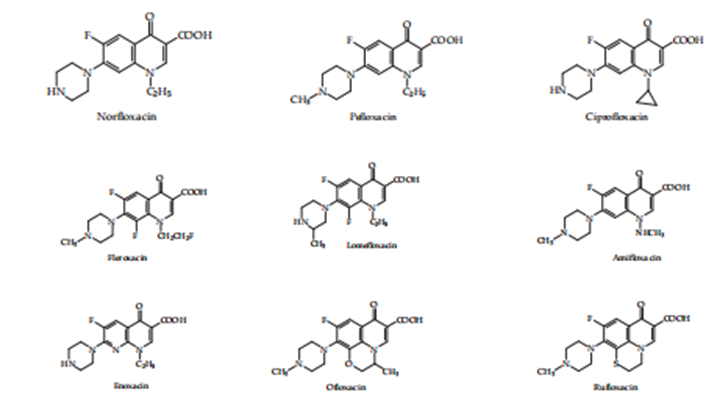
Figure 2. Second-generation quinolones.
The research on derivatives accompanying quinolone construction has led to new compounds acquired currently, which have existed top-secret as triennial and fourth creation intrinsic quinolones, which are largely effective against Staphylococcus aureus. Their big, completely clean spectrum includes anaerobes, Chlamydia, and Mycoplasma. (Brighty & Gootz, 2000) {5}
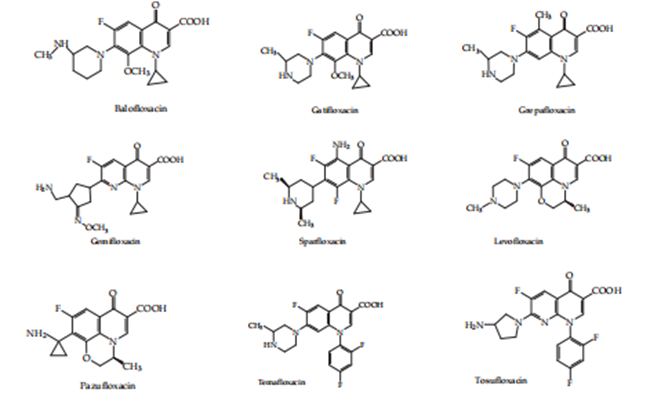
Figure 3: Third- generation quinolones.
The four productions have the following coarse aspects: a similar method of action by restriction, A subunit of DNA-gyrase, a particularly chromosomal bacterial opposition and a few similar microorganisms: photo toxicity, neurotoxicity, and animate skeleton toxicity.
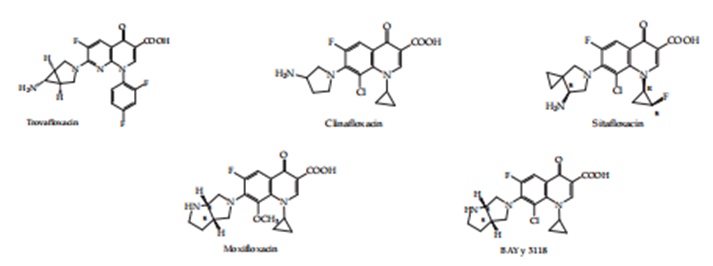
Figure. 4. Fourth- generation quinolones.
Until now, a lot of antibacterial essences owned by the above-noticed This class happened used in medicine. Quinolones are secondhand when considering infections of the urinary area, the respiring tract, stomach contaminations, ear/nose/neck contaminations, STDs, soft fabric and skin infection, meningitis caused by Gram-negative bacteria, and Staphylococci microorganisms, liver and hostility infections, infection of blood and endocarditis, precautions, and surgical infections and cases with immune imperfections. The system of operation of quinolone-uncontaminated powers includes the restriction of DNA gyrase (bacterial topoisomerase II), resulting in a brisk and uncontaminated effect. The uncontaminated exercise of quinolones (calculated in agreements of MIC) is still the result of consolidation of bacterial container seepage and DNA gyrase inhibitory activity. The decontaminating project of quinolones depends not only on the bi cyclic hetero aromatic method joining the 1,4-pyrido-4-pyridine-3-carboxylic acid subdivision and a pungent ring but also on the character of the minor substituents and their relation to space relationships. These substituents utilize their influence on a bacterial project by providing supplementary closeness for Bacterial enzymes, embellishing container seepage, or changes in pharmacokinetics. In general, research on ideal quinolones persists. Such a quinolone must be biologically alive on a large range of grandam definite and grandam negative microorganisms, aerobes and anaerobes and mycobacteria must have as few aftereffects as likely, which is wonderful solubility in water, and spoken bioavailability. In Figure 5, the ultimate common combined synthetic differences got all the attention of the research for new quinolones accompanying decontamination ventures.
1. Quinolones: Structural countenance and procedure of synthesis
2. 2.1 Structural face Quinolone products are a major class of uncontaminated power that accompany expansive operations. Basic construction of these compounds (Figure 6) is a bi cyclic construction, which holds a ring of type A 4-piridinona linked accompanying savory or hetero aromatic ring B. The ring aggressive personality 4-Piridinona is a ring accompanying certain needs: an unsaturation available in 2–3, a free acid function prepared 3, and a substituent at the nitrogen at position 1.

Figure 5: Structural variations of the most recent quinolones.
2.1.1 Bi cyclic quinolones
Position 1
The studies on quinolones indicated that for the compound to have a decontaminating venture, the N-1 position requires a substituent. Many quinolones are present in the N position. ethyl (norfloxacin, pefloxacin, and lomefloxacin), fluoroethyl (fleroxacin), vinyl, chloroethyl, trifluoromethyl, aminoethyl, cyclopropyl (ciprofloxacin), t-butyl, bi-cyclopentyl, p-fluorophenyl, 2,4-fluorophenyl (Scott 1997) {6}
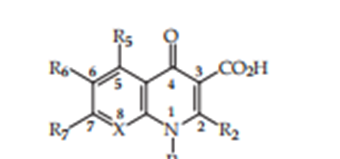
Figure. 7. Basic structure of bi cyclic quinolones.

R = H, methyl, ethyl, substituted phenyl
R6= F, Cl
R7= hetero cycle
Figure 8,7: Substituted-6-halo-4-oxo-4H-[1,3]-thiazeto[3,2]quinolin-3-carboxilyc acid.
Position 2
Quinolones were held at the C-2 hydrogen (R2=H). The substitute for hydrogen has mainly demonstrates the expected disadvantages. However, few compounds hold an appropriate C-1, C-2 The ring is currently used to seize organic exercises. (Figure 7, Segawa 1992) {7} (Figure 8 (Scott, 1997) C-3 carboxylic acid subdivision is most often confronted. (Chu & Fernandes 1991). In the late 1980s, a qualification was depicted that removed the need for C-3 carboxylic acid. A melted isothiazolinone ring was labeled as a symbol of a carboxylic acid mimic. Compound A-62824 (Figure 9). have been found with biological activity

Figure. 9. Quinolones with sulfur substituent at C-2.

Figure. 10. A-62824.
Position 4
The C-4 oxo group of the quinolone core is mainly deliberate and expected to be essential for uncontaminated venture. Position 5
The choice of the C-5 substituent performs expected commands for one of the steric rules and the types of N-1 and C-8 substituents (Chu & Fernandes, 1991). (R5 = methyl, element, amino) when X = CF)
Position 6
The type of C-6 substituent has an excellent effect on the DNA-gyrase inhibitory exercise and container seepage. (Domagala et al., 1986) {8}. The R6 maybe H, Cl, F, NO2, NH2, CN, CH3SCH3, COCH3 (Koga and others, 1980)
Position 7
The choice of the C-7 substituent is a key issue that persists in guiding the design of new Uncontaminated Quinolones. R7 can be substituted with or unsubstituted piperazine. amino pyrrolidines and aminoalkyl pyrrolidines (Figure 5) (Chu and Fernandes 1991) (Scott 1997).
Position 8
The most accepted alternatives at the C-8 position are hydrogen modicum (X= CH) or a nitrogen Jot (naphthyridine) (X=N). However, the compact lipophilic group (X = CF, C-CF3, CCl, and C OCH3) increases the quality of the venture. (Chu and Fernandes, 1991; Scott, 1997).
2.2 Method of synthesis
Gould-Jacob’s pattern
Quinolones are artificial in origin. (Chu & Fernandes, 1991). The lowest artificial method to make quinolone descendants is the Gould-Jacobs procedure (Figure 11). This order is secondhand primarily for a combination of compounds accompanying

Figure 11. Gould-Jacob’s method.
N-1 alkyl substituents and resides in the abridgment of anilines (II) accompanying diethyl ethoxymethylenemalonate (EMME), and the cyclization of anilinomethylene malonate. Thermal cyclization can be carried out in dow term (Koga, others, 1980), chlorosulfonic acid, oleum acid, or a combination of chlorosulfonic acid, and oleum acid (Saukaita and Gupton, 1996). The key go-between acquired (IV or X) will sustain an alkylation (Koga and others, 1980), cyclo alkylation accompanying bromo cyclopropane (Kazimierozaack & Pyznar, 1987) {9}, (Sanjose & Ulpiano, 1986) {10}, or accompanying 1-Bromo-1-ethoxy-cyclopropane, arylation accompanying para-nitro-chlorogenic or 2,4-dinitro-chlorogenic (Raddl &Zikan, 1989) {11} in consideration of placing the substituent prepared 1 of the quinolone cores. The ethyl ester (V) sustains a hydrolysis response, and the quinoline-3-carboxylic acid (VI), following regiospecific replacement of the 7-chloro group leads to the ending compounds (VIII). Figure 11 exemplifies again, orders for combining 1-cyclopropyl-quinolones offset for the anilines in recipe II. Anilines (II) is reacted accompanying 1-bromo-1-ethoxy-cyclopropane (Ramos & Garcia, 1994; Scriewer and others, 1988) {12,13} or a cyclopropyl-metallic compound (McGuirk 1989) {14}. Alternatively, N-ethyl substituted anilines of rule XV concede the possibility of being made by diminutive amination accompanying an appropriate aldehyde and an appropriate lowering

Figure 12: The modified Gould-Jacobs method.

Figure. 13. Method requiers the reaction of isatoic anhydride with sodium ethyl formyl acetate
Power: diborane, palladium on element accompanying hydrogen, sodium borohydride or sodium cyano borohydride (McGuirk) 1989) (Ramos 1994). N-isopropyl-substituted quinolones can be formed by alkylation accompanying Isopropyl bromide (Pintilie and others, September 2009) {15} (Pintilie et al., Oct. 2009),{16} (Pintilie and others, 2010) {17}, of compounds IV. (Figure 11). The changed Gould-Jacobs procedure will more be secondhand, placing the diethyl Ethoxymethylenemalonate reacted with mono substituted N-aniline (XVII) (Figure 12). The aniline (XVII) is obtained by subtractive amination of ketones and aldehydes accompanying sodium borohydride-tart acid (Itoh & Kato 1984) {18} or triacetoxyborohydride. (Pintilie et al. 2009). (Pintilie and others. 2010){19}
The method requires the backlash of isotonic anhydride with sodium ethyl formyl acetate Another combination order requires the response of isotonic anhydride accompanying sodio-ethyl formyl acetate (Figure 13). 2,4,5-trihalobenzoic acid (XX) is reacted with an appropriate amine, and before is acted upon, accompanying the compound: R2R3CO (R2 = R3 = Cl, CCl3O or R2= C1-10 alkyl, and R3 = Cl) to produce benzoxazindione (XXII). Therefore, the benzoxazine dione (XXII) was shortened to the accompanying compound (HOCH=CHCO2Et) to specify the key compound (V). Intramolecular nucleophilic dislocation cyclization route to quinolones (a) An effective and regiospecific combining by way of an intramolecular nucleophilic dislocation
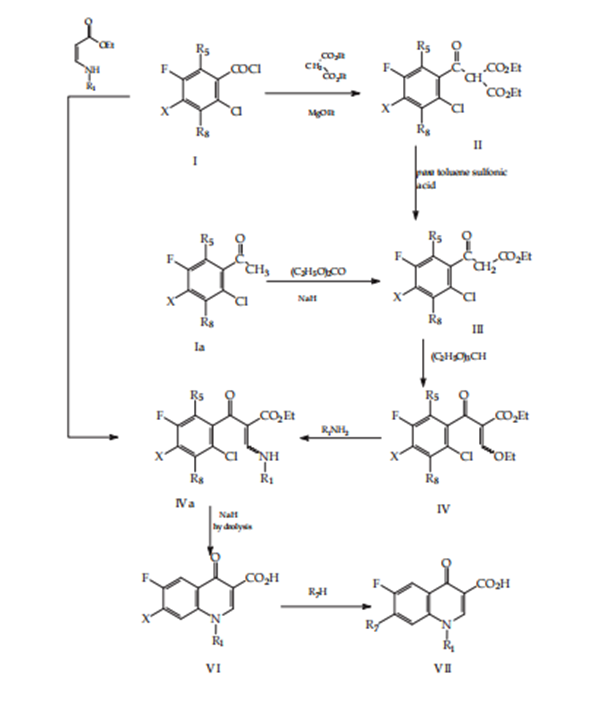
Figure. 14. Intramolecular nucleophilic displacement cyclization route to quinolones (a).
The cyclization response is also described. (Chu, 1985) (Figure 14). The key compound (III) may be acquired by
• backlash of benzoic acid chloride (I) accompanying ethyl malonic acid; the compound (II) present the compound (III).(Petersen & Grohe 1984a),{20} (Petersen & Grohe 1984b),{21}
• acetophenone (Ia) is concentrated along with diethyl carbonate in the demeanor of sodium hydride (Chu and others, 1985){22} Intermediates (III) react with accompanying tart anhydride in the ghost trietilortoformiate to produces 3-ethoxy-2-benzoyl-ethyl acrylate (IV). Compound (IV) is further reacted to, accompanying an appropriate amine in dichloromethane at range hotness to specify 3-anilino-2-benzoyl ethyl acrylate (IVa). Compound (IVa) may still be derived from benzoic acid chloride (I). (Chu & Fernandes 1991). Treatment with a base induces cyclization, producing quinolones (V). Intramolecular nucleophilic dislocation cyclization route to quinolones (b) A combination order similar to that characterized above is shown in Figure 15. This design includes intramolecular cyclization of compound (VIII). (Egawa and others. 1987).{23}
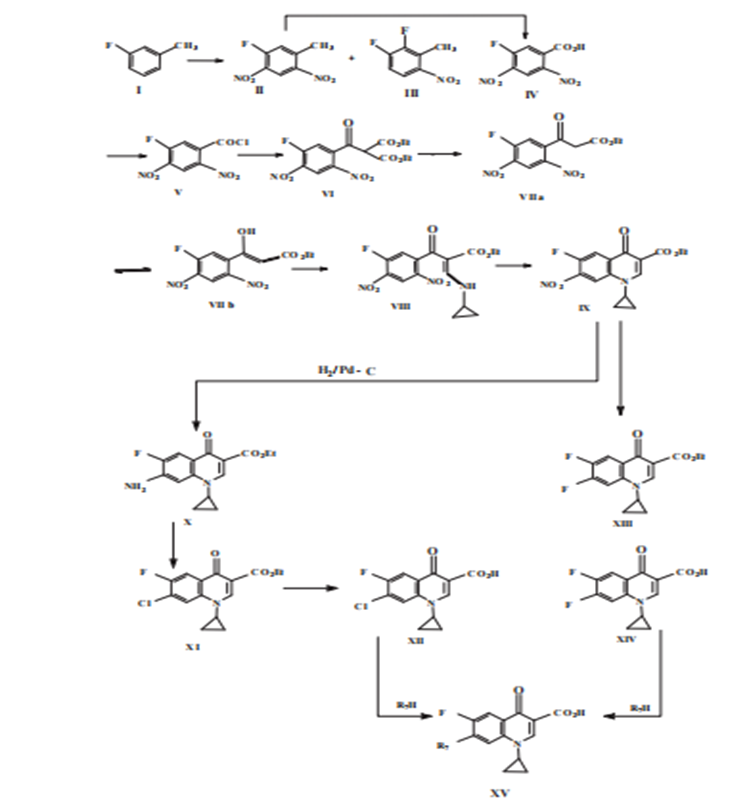
Figure. 15. Intramolecular nucleophilic displacement cyclization route to quinolones (b).
2.3 Structure of the New Compounds
This paper presents an exploratory dossier concerning the combination of various quinolones accompanying approximate rule: (Figure 16)
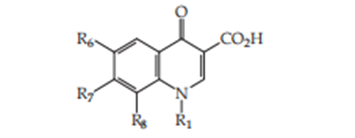
Figure. 16. The structure of the new compounds.
R1 = ethyl, isopropyl, 2-buthyl, 2-penthyl, benzyl, alkyl, p-nitrophenyl, p-amino-phenyl
R6 = hydrogen, fluor, chlor, methyl
R7 = 3-methyl-piperazinyl, 4-methyl-piperazinyl, piperidinyl, 3-methyl-piperidinyl,
4-methyl-piperidinyl, pyrrolidinyl, morpholinyl, and homopiperazinyl
R8 = hydrogen, chlorine, methyl, methoxy, nitro
2.4 Synthesis Pathway
The combination of the novel quinolones underwent a Gould-Jacobs cyclization process (Figure 17). An appropriate unsubstituted aniline (1) is reacted with accompanying diethyl ethoxy methylene malonate (EMME) to produce anilinomethylenemalonate (2). An after-warm process induces Gould-Jacob’s cyclization to afford the corresponding 4-hydroxyquinoline-3-carboxylate ester (3). (R6 = fluoro, chloro, methyl, and hydrogen) (Pintilie and others.2009a) (Pintilie et al. 2009b) (Pintilie et al. 2010).

Figure. 17. Synthesis of the new quinolones.
The following step is the alkylation of the 4-hidroxy-quinoline-3-carboxylate ester (3). that is customarily skilled by responding with an appropriate alkyl halide, dialkyl sulfates, and covering halide to produce quinolone 3-carboxylate ester (6). (R1 = ethyl, allyl, benzyl, and p-nitrophenyl)
(Pintilie and others, 2003a); (Pintilie and others, 2003b); (Pintilie and others, 2003c);{24} (Pintilie & Nita, 2011). A reduced approach resorts to the use of a mono substituted aniline (4) as an offset material to avoid N-1-amine alkylation (R1 = isopropyl, 2-butyl, 2-pentyl). (Pintilie and others, 2009a); (Pintilie and others, 2009b); (Pintilie and others, 2010). A powerful acid (to a degree, polyphosphoric) acid) is frequently used to encourage cyclization, which straightforwardly occurs in the composition of N-isopropyl-4-oxo-quinolone-3-carboxylate ester (6) (R1 = isopropyl, 2-butyl, 2-pentyl). In either case, the ending guidance is acid or fundamental hydrolysis to split the ester and create the biological Five free carboxylic acids (7). The biologically
alive free carboxylic acid (7) was further acquired from the equivalent 4-hidroxy-quinoline-3-carboxylate ester (3) by alkylation accompanying dialkyl sulfates in the presence of the opposite of an acid; for instance, the response it can skillfully complete activity in liquid 40% sodium hydroxide resolution. The dislocation of the 7-chloro group was accompanied by hetero cycle-allowed compounds (8). The combining of new 1-aryl quinoline-3-carboxylic acids corresponds to Figure 18. compound (3) (R6=F, Cl, CH3) is a direct N-arylation reaction. Treatment of (3) accompanying potassium carbonate in DMSO and p-fluoro-nitrobenzene (9). The esters were hydrolyzed to the appropriate acids (10) by refluxing, accompanied by a combination of hydrochloric and tartaric acids, upon the situation accompanying a hetero cycle surrendered compound (11). 1-(p-Aminophenyl)-quinoline-3-carboxylic acid (12) may be caused by a prevalent decline in the nitro group using sodium dithionite.

Figure. 18. Sinthesys of 1-aryl-quinolones.
The synthesis of the new 8-substituted quinoline-3-carboxylic acid is shown in Fig. 19. 8-Chloro-quinoline-3-carboxylic acids (13) were combined from 8-unsubstituted quinoline-3- carboxylic acids by chlorination with sulphuryl chloride. 8-Methoxy-quinoline-3-carboxylic Acids (14) were arranged to admit compounds (13) to obtain a soluble metallic alcohol.

Figure. 19. Sinthesys of the new 8-substituted quinoline-3-carboxylic acids.
2.5 New compounds: Structure and antimicrobial endeavor
2.5.1 Structure of the New Compounds
A succession of new 4-oxo-1,4-dihydroquinoline-3-carboxylic acids were combined. (Figure 20)

Figure. 20. Structure of the new compounds.
(Table 1)


Table 1. 4-Oxo- 1,4-dihydro-quinoline-3-carboxylic acids synthesized in this paper.
2.5.2 Antibacterial action of the new compounds
The new compounds were judged for “artificial” action by deciding minimum inhibitory aggregation against of microorganisms Escherichia.
Coli, Staphylococcus. Aureus and Pseudomonas. aeruginosa, by agar something for dunking design (Buiuc 1998) (NCCLS 2003). {25,26} (Table 2).
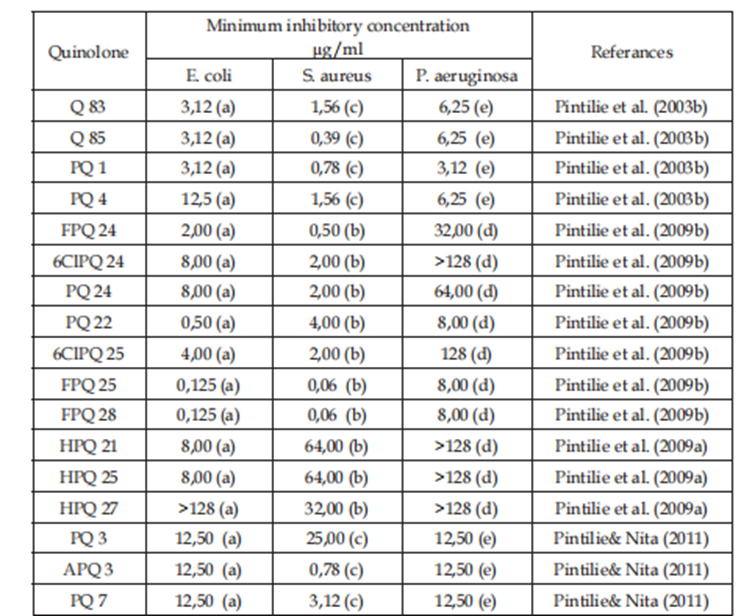
a. Escherichia. coli ATCC 25922, b. Staphylococcus. aureus ATCC29213, c. Staphylococcus. aureus ATCC29223,
d. Pseudomonas .aeruginosa ATCC27813,e. Pseudomonas .aeruginosa ATCC27853
Table 2. “In vitro” antibacterial activity of the new quinolones.
This study uses a versatile approach to investigate the decontamination project of recently synthesized quinolone products. The combining of these descendants was achieved through an order of traditional synthetic reactions, with painstaking concern given to optimizing backlash environments for improved yields. Characterization techniques, including basic attractive resonance (NMR) spectroscopy and bulk spectrometry, were working to validate the structural uprightness of the combined compounds.
Antibacterial venture assessments were conducted using a committee of clinically relevant bacterial strains. Standard microbiological arrangements, containing platter diffusion and minimum inhibitory aggregation (MIC) assays, were working to determine the susceptibility of the bacterial isolates to the quinolone descendants. Quality control measures were executed to guarantee the accuracy and reproducibility of the results
The synthesis of quinolones was carried out using a series of chemical reactions, starting with the cyclization of N-alkylation anthranilic acids. various substituents were introduced at key positions to evaluate their impact on antibacterial activity. The synthesized quinolone derivatives were characterized using NMR, IR, and mass spectrometry.
The introduction of fluorine on the C-6 position and piperazine on the C-7 position resulted in derivatives with significantly enhanced antibacterial activity against Gram- negative bacteria. this modification improved the compounds' lipophilicity and cellular uptake, leading to increased efficacy. The findings suggest that further, structural modifications could yield quinolone derivatives with even broader antibacterial spectra and better pharmacokinetic properties. This study highlights the potential for developing new quinolone antibiotics with improved therapeutic profiles through targeted chemical modifications
In conclusion, we synthesized new quinolones and evaluated their decontaminating capacity. The consequences indicate that substituent combos in the quinolone ring can produce effective decontaminating retailers. particularly, the compound FPQ-28 (1-ethyl-6-fluoro-7-morpholinyl-8-chloro-1,4-dihydro-four-oxo-quinoline-3-carboxylic acid) (determine 21), in step with QSAR research (Tarko et al., 2008), established giant synthetic activity towards E. coli ATCC 25922 (MIC 0. a hundred 25 µg/mL) and S. aureus ATCC 29213 (MIC 0.06 µg/mL).
parent 21. 1-Ethyl-6-fluoro-7-morpholinyl-8-chloro-1,4-dihydro-4-oxo-quinoline-three-carboxylic acid (FPQ-28).
FPQ-28 NMR and IR spectra:
1H-NMR (DMSO-d6, δ ppm, J Hz):
8.97 (s, 1H, H-2)
8.07 (d, 1H, H-5, 11.8)
4.89 (q, 2H, H-17, 7.2)
3.82 (m, 4H, syst. A2B2, H-13-15)
3.37 (m, 4H, syst. A2B2, H-12-16)
1.46 (t, 3H, H-18, 7.2)
13C-NMR (DMSO-d6, δ ppm, J Hz):
175.56 (C-4)
166.12 (C-21)
154.95 (d, J(13C-19F)=254.8, C-6)
158.37 (Cq)
153.04 (C-2)
125.94 (Cq)
124.76 (Cq)
116.86 (Cq)
111.57 (d, J(13C-19F)=23.5, C-5)
98.35 (C-3)
67.23 (C-13-15)
53.64 (C-12-16)
51.58 (C-17)
16.14 (C-18)
ft-IR (strong in ATR, ν cm-1):
3056, 2957, 2895, 2849, 1717, 1615, 1558, 1532, 1492, 1435, 1376, 1300, 1253, 1207, 1102, 1033, 980, 920, 890, 846, 803, 740, 651, 528, 464.
The completion of this research project would not have been possible without the contributions and support of many individuals and organizations. We are deeply grateful to all those who played a role in the success of this project We would also like to thank My Mentor [. Naweed Imam Syed Prof. Department of Cell Biology at the University of Calgary and Dr. Sadaf Ahmed Psychophysiology Lab University of Karachi for their invaluable input and support throughout the research. Their insights and expertise were instrumental in shaping the direction of this project
Declaration of Interest
I at this moment declare that
I have no pecuniary or other personal interest, direct or indirect, in any matter that raises or may raise a conflict with my duties as a manager of my office Management
Conflicts of Interest
The authors declare that they have no conflicts of interest.
Financial support and sponsorship
No Funding was received to assist with the preparation of this manuscript
Clearly Auctoresonline and particularly Psychology and Mental Health Care Journal is dedicated to improving health care services for individuals and populations. The editorial boards' ability to efficiently recognize and share the global importance of health literacy with a variety of stakeholders. Auctoresonline publishing platform can be used to facilitate of optimal client-based services and should be added to health care professionals' repertoire of evidence-based health care resources.

Journal of Clinical Cardiology and Cardiovascular Intervention The submission and review process was adequate. However I think that the publication total value should have been enlightened in early fases. Thank you for all.

Journal of Women Health Care and Issues By the present mail, I want to say thank to you and tour colleagues for facilitating my published article. Specially thank you for the peer review process, support from the editorial office. I appreciate positively the quality of your journal.
Journal of Clinical Research and Reports I would be very delighted to submit my testimonial regarding the reviewer board and the editorial office. The reviewer board were accurate and helpful regarding any modifications for my manuscript. And the editorial office were very helpful and supportive in contacting and monitoring with any update and offering help. It was my pleasure to contribute with your promising Journal and I am looking forward for more collaboration.

We would like to thank the Journal of Thoracic Disease and Cardiothoracic Surgery because of the services they provided us for our articles. The peer-review process was done in a very excellent time manner, and the opinions of the reviewers helped us to improve our manuscript further. The editorial office had an outstanding correspondence with us and guided us in many ways. During a hard time of the pandemic that is affecting every one of us tremendously, the editorial office helped us make everything easier for publishing scientific work. Hope for a more scientific relationship with your Journal.

The peer-review process which consisted high quality queries on the paper. I did answer six reviewers’ questions and comments before the paper was accepted. The support from the editorial office is excellent.

Journal of Neuroscience and Neurological Surgery. I had the experience of publishing a research article recently. The whole process was simple from submission to publication. The reviewers made specific and valuable recommendations and corrections that improved the quality of my publication. I strongly recommend this Journal.

Dr. Katarzyna Byczkowska My testimonial covering: "The peer review process is quick and effective. The support from the editorial office is very professional and friendly. Quality of the Clinical Cardiology and Cardiovascular Interventions is scientific and publishes ground-breaking research on cardiology that is useful for other professionals in the field.

Thank you most sincerely, with regard to the support you have given in relation to the reviewing process and the processing of my article entitled "Large Cell Neuroendocrine Carcinoma of The Prostate Gland: A Review and Update" for publication in your esteemed Journal, Journal of Cancer Research and Cellular Therapeutics". The editorial team has been very supportive.

Testimony of Journal of Clinical Otorhinolaryngology: work with your Reviews has been a educational and constructive experience. The editorial office were very helpful and supportive. It was a pleasure to contribute to your Journal.

Dr. Bernard Terkimbi Utoo, I am happy to publish my scientific work in Journal of Women Health Care and Issues (JWHCI). The manuscript submission was seamless and peer review process was top notch. I was amazed that 4 reviewers worked on the manuscript which made it a highly technical, standard and excellent quality paper. I appreciate the format and consideration for the APC as well as the speed of publication. It is my pleasure to continue with this scientific relationship with the esteem JWHCI.

This is an acknowledgment for peer reviewers, editorial board of Journal of Clinical Research and Reports. They show a lot of consideration for us as publishers for our research article “Evaluation of the different factors associated with side effects of COVID-19 vaccination on medical students, Mutah university, Al-Karak, Jordan”, in a very professional and easy way. This journal is one of outstanding medical journal.
Dear Hao Jiang, to Journal of Nutrition and Food Processing We greatly appreciate the efficient, professional and rapid processing of our paper by your team. If there is anything else we should do, please do not hesitate to let us know. On behalf of my co-authors, we would like to express our great appreciation to editor and reviewers.

As an author who has recently published in the journal "Brain and Neurological Disorders". I am delighted to provide a testimonial on the peer review process, editorial office support, and the overall quality of the journal. The peer review process at Brain and Neurological Disorders is rigorous and meticulous, ensuring that only high-quality, evidence-based research is published. The reviewers are experts in their fields, and their comments and suggestions were constructive and helped improve the quality of my manuscript. The review process was timely and efficient, with clear communication from the editorial office at each stage. The support from the editorial office was exceptional throughout the entire process. The editorial staff was responsive, professional, and always willing to help. They provided valuable guidance on formatting, structure, and ethical considerations, making the submission process seamless. Moreover, they kept me informed about the status of my manuscript and provided timely updates, which made the process less stressful. The journal Brain and Neurological Disorders is of the highest quality, with a strong focus on publishing cutting-edge research in the field of neurology. The articles published in this journal are well-researched, rigorously peer-reviewed, and written by experts in the field. The journal maintains high standards, ensuring that readers are provided with the most up-to-date and reliable information on brain and neurological disorders. In conclusion, I had a wonderful experience publishing in Brain and Neurological Disorders. The peer review process was thorough, the editorial office provided exceptional support, and the journal's quality is second to none. I would highly recommend this journal to any researcher working in the field of neurology and brain disorders.

Dear Agrippa Hilda, Journal of Neuroscience and Neurological Surgery, Editorial Coordinator, I trust this message finds you well. I want to extend my appreciation for considering my article for publication in your esteemed journal. I am pleased to provide a testimonial regarding the peer review process and the support received from your editorial office. The peer review process for my paper was carried out in a highly professional and thorough manner. The feedback and comments provided by the authors were constructive and very useful in improving the quality of the manuscript. This rigorous assessment process undoubtedly contributes to the high standards maintained by your journal.

International Journal of Clinical Case Reports and Reviews. I strongly recommend to consider submitting your work to this high-quality journal. The support and availability of the Editorial staff is outstanding and the review process was both efficient and rigorous.

Thank you very much for publishing my Research Article titled “Comparing Treatment Outcome Of Allergic Rhinitis Patients After Using Fluticasone Nasal Spray And Nasal Douching" in the Journal of Clinical Otorhinolaryngology. As Medical Professionals we are immensely benefited from study of various informative Articles and Papers published in this high quality Journal. I look forward to enriching my knowledge by regular study of the Journal and contribute my future work in the field of ENT through the Journal for use by the medical fraternity. The support from the Editorial office was excellent and very prompt. I also welcome the comments received from the readers of my Research Article.

Dear Erica Kelsey, Editorial Coordinator of Cancer Research and Cellular Therapeutics Our team is very satisfied with the processing of our paper by your journal. That was fast, efficient, rigorous, but without unnecessary complications. We appreciated the very short time between the submission of the paper and its publication on line on your site.

I am very glad to say that the peer review process is very successful and fast and support from the Editorial Office. Therefore, I would like to continue our scientific relationship for a long time. And I especially thank you for your kindly attention towards my article. Have a good day!

"We recently published an article entitled “Influence of beta-Cyclodextrins upon the Degradation of Carbofuran Derivatives under Alkaline Conditions" in the Journal of “Pesticides and Biofertilizers” to show that the cyclodextrins protect the carbamates increasing their half-life time in the presence of basic conditions This will be very helpful to understand carbofuran behaviour in the analytical, agro-environmental and food areas. We greatly appreciated the interaction with the editor and the editorial team; we were particularly well accompanied during the course of the revision process, since all various steps towards publication were short and without delay".

I would like to express my gratitude towards you process of article review and submission. I found this to be very fair and expedient. Your follow up has been excellent. I have many publications in national and international journal and your process has been one of the best so far. Keep up the great work.

We are grateful for this opportunity to provide a glowing recommendation to the Journal of Psychiatry and Psychotherapy. We found that the editorial team were very supportive, helpful, kept us abreast of timelines and over all very professional in nature. The peer review process was rigorous, efficient and constructive that really enhanced our article submission. The experience with this journal remains one of our best ever and we look forward to providing future submissions in the near future.

I am very pleased to serve as EBM of the journal, I hope many years of my experience in stem cells can help the journal from one way or another. As we know, stem cells hold great potential for regenerative medicine, which are mostly used to promote the repair response of diseased, dysfunctional or injured tissue using stem cells or their derivatives. I think Stem Cell Research and Therapeutics International is a great platform to publish and share the understanding towards the biology and translational or clinical application of stem cells.

I would like to give my testimony in the support I have got by the peer review process and to support the editorial office where they were of asset to support young author like me to be encouraged to publish their work in your respected journal and globalize and share knowledge across the globe. I really give my great gratitude to your journal and the peer review including the editorial office.

I am delighted to publish our manuscript entitled "A Perspective on Cocaine Induced Stroke - Its Mechanisms and Management" in the Journal of Neuroscience and Neurological Surgery. The peer review process, support from the editorial office, and quality of the journal are excellent. The manuscripts published are of high quality and of excellent scientific value. I recommend this journal very much to colleagues.

Dr.Tania Muñoz, My experience as researcher and author of a review article in The Journal Clinical Cardiology and Interventions has been very enriching and stimulating. The editorial team is excellent, performs its work with absolute responsibility and delivery. They are proactive, dynamic and receptive to all proposals. Supporting at all times the vast universe of authors who choose them as an option for publication. The team of review specialists, members of the editorial board, are brilliant professionals, with remarkable performance in medical research and scientific methodology. Together they form a frontline team that consolidates the JCCI as a magnificent option for the publication and review of high-level medical articles and broad collective interest. I am honored to be able to share my review article and open to receive all your comments.

“The peer review process of JPMHC is quick and effective. Authors are benefited by good and professional reviewers with huge experience in the field of psychology and mental health. The support from the editorial office is very professional. People to contact to are friendly and happy to help and assist any query authors might have. Quality of the Journal is scientific and publishes ground-breaking research on mental health that is useful for other professionals in the field”.

Dear editorial department: On behalf of our team, I hereby certify the reliability and superiority of the International Journal of Clinical Case Reports and Reviews in the peer review process, editorial support, and journal quality. Firstly, the peer review process of the International Journal of Clinical Case Reports and Reviews is rigorous, fair, transparent, fast, and of high quality. The editorial department invites experts from relevant fields as anonymous reviewers to review all submitted manuscripts. These experts have rich academic backgrounds and experience, and can accurately evaluate the academic quality, originality, and suitability of manuscripts. The editorial department is committed to ensuring the rigor of the peer review process, while also making every effort to ensure a fast review cycle to meet the needs of authors and the academic community. Secondly, the editorial team of the International Journal of Clinical Case Reports and Reviews is composed of a group of senior scholars and professionals with rich experience and professional knowledge in related fields. The editorial department is committed to assisting authors in improving their manuscripts, ensuring their academic accuracy, clarity, and completeness. Editors actively collaborate with authors, providing useful suggestions and feedback to promote the improvement and development of the manuscript. We believe that the support of the editorial department is one of the key factors in ensuring the quality of the journal. Finally, the International Journal of Clinical Case Reports and Reviews is renowned for its high- quality articles and strict academic standards. The editorial department is committed to publishing innovative and academically valuable research results to promote the development and progress of related fields. The International Journal of Clinical Case Reports and Reviews is reasonably priced and ensures excellent service and quality ratio, allowing authors to obtain high-level academic publishing opportunities in an affordable manner. I hereby solemnly declare that the International Journal of Clinical Case Reports and Reviews has a high level of credibility and superiority in terms of peer review process, editorial support, reasonable fees, and journal quality. Sincerely, Rui Tao.

Clinical Cardiology and Cardiovascular Interventions I testity the covering of the peer review process, support from the editorial office, and quality of the journal.

Clinical Cardiology and Cardiovascular Interventions, we deeply appreciate the interest shown in our work and its publication. It has been a true pleasure to collaborate with you. The peer review process, as well as the support provided by the editorial office, have been exceptional, and the quality of the journal is very high, which was a determining factor in our decision to publish with you.
The peer reviewers process is quick and effective, the supports from editorial office is excellent, the quality of journal is high. I would like to collabroate with Internatioanl journal of Clinical Case Reports and Reviews journal clinically in the future time.

Clinical Cardiology and Cardiovascular Interventions, I would like to express my sincerest gratitude for the trust placed in our team for the publication in your journal. It has been a true pleasure to collaborate with you on this project. I am pleased to inform you that both the peer review process and the attention from the editorial coordination have been excellent. Your team has worked with dedication and professionalism to ensure that your publication meets the highest standards of quality. We are confident that this collaboration will result in mutual success, and we are eager to see the fruits of this shared effort.

Dear Dr. Jessica Magne, Editorial Coordinator 0f Clinical Cardiology and Cardiovascular Interventions, I hope this message finds you well. I want to express my utmost gratitude for your excellent work and for the dedication and speed in the publication process of my article titled "Navigating Innovation: Qualitative Insights on Using Technology for Health Education in Acute Coronary Syndrome Patients." I am very satisfied with the peer review process, the support from the editorial office, and the quality of the journal. I hope we can maintain our scientific relationship in the long term.
Dear Monica Gissare, - Editorial Coordinator of Nutrition and Food Processing. ¨My testimony with you is truly professional, with a positive response regarding the follow-up of the article and its review, you took into account my qualities and the importance of the topic¨.

Dear Dr. Jessica Magne, Editorial Coordinator 0f Clinical Cardiology and Cardiovascular Interventions, The review process for the article “The Handling of Anti-aggregants and Anticoagulants in the Oncologic Heart Patient Submitted to Surgery” was extremely rigorous and detailed. From the initial submission to the final acceptance, the editorial team at the “Journal of Clinical Cardiology and Cardiovascular Interventions” demonstrated a high level of professionalism and dedication. The reviewers provided constructive and detailed feedback, which was essential for improving the quality of our work. Communication was always clear and efficient, ensuring that all our questions were promptly addressed. The quality of the “Journal of Clinical Cardiology and Cardiovascular Interventions” is undeniable. It is a peer-reviewed, open-access publication dedicated exclusively to disseminating high-quality research in the field of clinical cardiology and cardiovascular interventions. The journal's impact factor is currently under evaluation, and it is indexed in reputable databases, which further reinforces its credibility and relevance in the scientific field. I highly recommend this journal to researchers looking for a reputable platform to publish their studies.

Dear Editorial Coordinator of the Journal of Nutrition and Food Processing! "I would like to thank the Journal of Nutrition and Food Processing for including and publishing my article. The peer review process was very quick, movement and precise. The Editorial Board has done an extremely conscientious job with much help, valuable comments and advices. I find the journal very valuable from a professional point of view, thank you very much for allowing me to be part of it and I would like to participate in the future!”

Dealing with The Journal of Neurology and Neurological Surgery was very smooth and comprehensive. The office staff took time to address my needs and the response from editors and the office was prompt and fair. I certainly hope to publish with this journal again.Their professionalism is apparent and more than satisfactory. Susan Weiner

My Testimonial Covering as fellowing: Lin-Show Chin. The peer reviewers process is quick and effective, the supports from editorial office is excellent, the quality of journal is high. I would like to collabroate with Internatioanl journal of Clinical Case Reports and Reviews.

My experience publishing in Psychology and Mental Health Care was exceptional. The peer review process was rigorous and constructive, with reviewers providing valuable insights that helped enhance the quality of our work. The editorial team was highly supportive and responsive, making the submission process smooth and efficient. The journal's commitment to high standards and academic rigor makes it a respected platform for quality research. I am grateful for the opportunity to publish in such a reputable journal.
My experience publishing in International Journal of Clinical Case Reports and Reviews was exceptional. I Come forth to Provide a Testimonial Covering the Peer Review Process and the editorial office for the Professional and Impartial Evaluation of the Manuscript.

I would like to offer my testimony in the support. I have received through the peer review process and support the editorial office where they are to support young authors like me, encourage them to publish their work in your esteemed journals, and globalize and share knowledge globally. I really appreciate your journal, peer review, and editorial office.
Dear Agrippa Hilda- Editorial Coordinator of Journal of Neuroscience and Neurological Surgery, "The peer review process was very quick and of high quality, which can also be seen in the articles in the journal. The collaboration with the editorial office was very good."

I would like to express my sincere gratitude for the support and efficiency provided by the editorial office throughout the publication process of my article, “Delayed Vulvar Metastases from Rectal Carcinoma: A Case Report.” I greatly appreciate the assistance and guidance I received from your team, which made the entire process smooth and efficient. The peer review process was thorough and constructive, contributing to the overall quality of the final article. I am very grateful for the high level of professionalism and commitment shown by the editorial staff, and I look forward to maintaining a long-term collaboration with the International Journal of Clinical Case Reports and Reviews.
To Dear Erin Aust, I would like to express my heartfelt appreciation for the opportunity to have my work published in this esteemed journal. The entire publication process was smooth and well-organized, and I am extremely satisfied with the final result. The Editorial Team demonstrated the utmost professionalism, providing prompt and insightful feedback throughout the review process. Their clear communication and constructive suggestions were invaluable in enhancing my manuscript, and their meticulous attention to detail and dedication to quality are truly commendable. Additionally, the support from the Editorial Office was exceptional. From the initial submission to the final publication, I was guided through every step of the process with great care and professionalism. The team's responsiveness and assistance made the entire experience both easy and stress-free. I am also deeply impressed by the quality and reputation of the journal. It is an honor to have my research featured in such a respected publication, and I am confident that it will make a meaningful contribution to the field.

"I am grateful for the opportunity of contributing to [International Journal of Clinical Case Reports and Reviews] and for the rigorous review process that enhances the quality of research published in your esteemed journal. I sincerely appreciate the time and effort of your team who have dedicatedly helped me in improvising changes and modifying my manuscript. The insightful comments and constructive feedback provided have been invaluable in refining and strengthening my work".

I thank the ‘Journal of Clinical Research and Reports’ for accepting this article for publication. This is a rigorously peer reviewed journal which is on all major global scientific data bases. I note the review process was prompt, thorough and professionally critical. It gave us an insight into a number of important scientific/statistical issues. The review prompted us to review the relevant literature again and look at the limitations of the study. The peer reviewers were open, clear in the instructions and the editorial team was very prompt in their communication. This journal certainly publishes quality research articles. I would recommend the journal for any future publications.

Dear Jessica Magne, with gratitude for the joint work. Fast process of receiving and processing the submitted scientific materials in “Clinical Cardiology and Cardiovascular Interventions”. High level of competence of the editors with clear and correct recommendations and ideas for enriching the article.

We found the peer review process quick and positive in its input. The support from the editorial officer has been very agile, always with the intention of improving the article and taking into account our subsequent corrections.

My article, titled 'No Way Out of the Smartphone Epidemic Without Considering the Insights of Brain Research,' has been republished in the International Journal of Clinical Case Reports and Reviews. The review process was seamless and professional, with the editors being both friendly and supportive. I am deeply grateful for their efforts.
To Dear Erin Aust – Editorial Coordinator of Journal of General Medicine and Clinical Practice! I declare that I am absolutely satisfied with your work carried out with great competence in following the manuscript during the various stages from its receipt, during the revision process to the final acceptance for publication. Thank Prof. Elvira Farina

Dear Jessica, and the super professional team of the ‘Clinical Cardiology and Cardiovascular Interventions’ I am sincerely grateful to the coordinated work of the journal team for the no problem with the submission of my manuscript: “Cardiometabolic Disorders in A Pregnant Woman with Severe Preeclampsia on the Background of Morbid Obesity (Case Report).” The review process by 5 experts was fast, and the comments were professional, which made it more specific and academic, and the process of publication and presentation of the article was excellent. I recommend that my colleagues publish articles in this journal, and I am interested in further scientific cooperation. Sincerely and best wishes, Dr. Oleg Golyanovskiy.

Dear Ashley Rosa, Editorial Coordinator of the journal - Psychology and Mental Health Care. " The process of obtaining publication of my article in the Psychology and Mental Health Journal was positive in all areas. The peer review process resulted in a number of valuable comments, the editorial process was collaborative and timely, and the quality of this journal has been quickly noticed, resulting in alternative journals contacting me to publish with them." Warm regards, Susan Anne Smith, PhD. Australian Breastfeeding Association.

Dear Jessica Magne, Editorial Coordinator, Clinical Cardiology and Cardiovascular Interventions, Auctores Publishing LLC. I appreciate the journal (JCCI) editorial office support, the entire team leads were always ready to help, not only on technical front but also on thorough process. Also, I should thank dear reviewers’ attention to detail and creative approach to teach me and bring new insights by their comments. Surely, more discussions and introduction of other hemodynamic devices would provide better prevention and management of shock states. Your efforts and dedication in presenting educational materials in this journal are commendable. Best wishes from, Farahnaz Fallahian.
Dear Maria Emerson, Editorial Coordinator, International Journal of Clinical Case Reports and Reviews, Auctores Publishing LLC. I am delighted to have published our manuscript, "Acute Colonic Pseudo-Obstruction (ACPO): A rare but serious complication following caesarean section." I want to thank the editorial team, especially Maria Emerson, for their prompt review of the manuscript, quick responses to queries, and overall support. Yours sincerely Dr. Victor Olagundoye.

Dear Ashley Rosa, Editorial Coordinator, International Journal of Clinical Case Reports and Reviews. Many thanks for publishing this manuscript after I lost confidence the editors were most helpful, more than other journals Best wishes from, Susan Anne Smith, PhD. Australian Breastfeeding Association.

Dear Agrippa Hilda, Editorial Coordinator, Journal of Neuroscience and Neurological Surgery. The entire process including article submission, review, revision, and publication was extremely easy. The journal editor was prompt and helpful, and the reviewers contributed to the quality of the paper. Thank you so much! Eric Nussbaum, MD
Dr Hala Al Shaikh This is to acknowledge that the peer review process for the article ’ A Novel Gnrh1 Gene Mutation in Four Omani Male Siblings, Presentation and Management ’ sent to the International Journal of Clinical Case Reports and Reviews was quick and smooth. The editorial office was prompt with easy communication.

Dear Erin Aust, Editorial Coordinator, Journal of General Medicine and Clinical Practice. We are pleased to share our experience with the “Journal of General Medicine and Clinical Practice”, following the successful publication of our article. The peer review process was thorough and constructive, helping to improve the clarity and quality of the manuscript. We are especially thankful to Ms. Erin Aust, the Editorial Coordinator, for her prompt communication and continuous support throughout the process. Her professionalism ensured a smooth and efficient publication experience. The journal upholds high editorial standards, and we highly recommend it to fellow researchers seeking a credible platform for their work. Best wishes By, Dr. Rakhi Mishra.

Dear Jessica Magne, Editorial Coordinator, Clinical Cardiology and Cardiovascular Interventions, Auctores Publishing LLC. The peer review process of the journal of Clinical Cardiology and Cardiovascular Interventions was excellent and fast, as was the support of the editorial office and the quality of the journal. Kind regards Walter F. Riesen Prof. Dr. Dr. h.c. Walter F. Riesen.

Dear Ashley Rosa, Editorial Coordinator, International Journal of Clinical Case Reports and Reviews, Auctores Publishing LLC. Thank you for publishing our article, Exploring Clozapine's Efficacy in Managing Aggression: A Multiple Single-Case Study in Forensic Psychiatry in the international journal of clinical case reports and reviews. We found the peer review process very professional and efficient. The comments were constructive, and the whole process was efficient. On behalf of the co-authors, I would like to thank you for publishing this article. With regards, Dr. Jelle R. Lettinga.

Dear Clarissa Eric, Editorial Coordinator, Journal of Clinical Case Reports and Studies, I would like to express my deep admiration for the exceptional professionalism demonstrated by your journal. I am thoroughly impressed by the speed of the editorial process, the substantive and insightful reviews, and the meticulous preparation of the manuscript for publication. Additionally, I greatly appreciate the courteous and immediate responses from your editorial office to all my inquiries. Best Regards, Dariusz Ziora

Dear Chrystine Mejia, Editorial Coordinator, Journal of Neurodegeneration and Neurorehabilitation, Auctores Publishing LLC, We would like to thank the editorial team for the smooth and high-quality communication leading up to the publication of our article in the Journal of Neurodegeneration and Neurorehabilitation. The reviewers have extensive knowledge in the field, and their relevant questions helped to add value to our publication. Kind regards, Dr. Ravi Shrivastava.

Dear Clarissa Eric, Editorial Coordinator, Journal of Clinical Case Reports and Studies, Auctores Publishing LLC, USA Office: +1-(302)-520-2644. I would like to express my sincere appreciation for the efficient and professional handling of my case report by the ‘Journal of Clinical Case Reports and Studies’. The peer review process was not only fast but also highly constructive—the reviewers’ comments were clear, relevant, and greatly helped me improve the quality and clarity of my manuscript. I also received excellent support from the editorial office throughout the process. Communication was smooth and timely, and I felt well guided at every stage, from submission to publication. The overall quality and rigor of the journal are truly commendable. I am pleased to have published my work with Journal of Clinical Case Reports and Studies, and I look forward to future opportunities for collaboration. Sincerely, Aline Tollet, UCLouvain.

Dear Ms. Mayra Duenas, Editorial Coordinator, International Journal of Clinical Case Reports and Reviews. “The International Journal of Clinical Case Reports and Reviews represented the “ideal house” to share with the research community a first experience with the use of the Simeox device for speech rehabilitation. High scientific reputation and attractive website communication were first determinants for the selection of this Journal, and the following submission process exceeded expectations: fast but highly professional peer review, great support by the editorial office, elegant graphic layout. Exactly what a dynamic research team - also composed by allied professionals - needs!" From, Chiara Beccaluva, PT - Italy.

Dear Maria Emerson, Editorial Coordinator, we have deeply appreciated the professionalism demonstrated by the International Journal of Clinical Case Reports and Reviews. The reviewers have extensive knowledge of our field and have been very efficient and fast in supporting the process. I am really looking forward to further collaboration. Thanks. Best regards, Dr. Claudio Ligresti
Dear Chrystine Mejia, Editorial Coordinator, Journal of Neurodegeneration and Neurorehabilitation. “The peer review process was efficient and constructive, and the editorial office provided excellent communication and support throughout. The journal ensures scientific rigor and high editorial standards, while also offering a smooth and timely publication process. We sincerely appreciate the work of the editorial team in facilitating the dissemination of innovative approaches such as the Bonori Method.” Best regards, Dr. Giselle Pentón-Rol.
